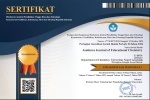The Effect of Contextual Teaching and Learning (CTL) Model on Reaction Rate Material on Critical Thinking Ability and Character of Student
Abstract
Keywords
Full Text:
PDFReferences
Ansani, & Samsir, H. M. (2022). Bandura's Modeling Theory. Jurnal Multidisiplin Madani, 2(7), 3067-3080. https://doi.org/https://doi.org/10.55927/mudima.v2i7.692
Anuraga, G., Indrasetianingsih, A., & Athoillah, M. (2021). Pelatihan Pengujian Hipotesis Statistika Dasar dengan Software R. BUDIMAS?: JURNAL PENGABDIAN MASYARAKAT, 3(2), 327-334. https://doi.org/https://doi.org/10.29040/budimas.v3i2.2412
Dai, S. W., Ischak, N. I., Iyabu, H., Laliyo, L. A. R., Aman, L. O., & Munandar, haris. (2022). Pengaruh Pembelajaran Guided Inquiry Berbasis Proyek pada Materi Makromolekul untuk Meningkatkan Kemampuan Berpikir Kritis Siswa. Experiment: Journal of Science Education, 2(1), 24-31. https://doi.org/https://doi.org/10.18860/experiment.v2i2.23034
Dewi, N. P. F. V, Dantes, N., & Gunamantha, I. M. (2023). Pengaruh Model Pembelajran Kontextual Teaching and Learning Berbasis Kemampuan Berfiki Kritis dan Hasil Belajar IPA Siswa. PENDASI: Jurnal Pendidikan Dasar Indonesia, 7(2), 207-217. https://doi.org/https://doi.org/10.23887/jurnal_pendas.v7i2.2393
Gonibala, A., Pikoli, M., & La Kilo, A. (2019). Validitas Perangkat Pembelajaran Materi Ikatan Kimia berbasis Model Pembelajaran Pemaknaan untuk Melatihkan Sensitivitas Moral Siswa SMA. Jambura Journal of Educational Chemistry, 1(1), 1-6. https://doi.org/https://doi.org/10.34312/jjec.v1i1.2067
Hamidah, I., & Citra, S. Y. (2021). Efektivitas Model Pembelajaran Project Based Learning (PjBL) terhadap Minat dan Hasil Belajar Siswa. BIOEDUSAINS:Jurnal Pendidikan Biologi Dan Sains, 4(2), 307-314. https://doi.org/https://doi.org/10.31539/bioedusains.v4i2.2870
Hasanah, N., Rasid, A. S., & Setiawan, T. (2022). Analisis Pengetahuan Laboratorium Kimia Siswa Kelas XI SMA se Kecamatan Jailolo. SAINTIFIK: Jurnal Matematika, Sains, Dan Pembelajarannya, 8(1), 37-45. https://doi.org/https://doi.org/10.31605/saintifik.v8i1.344
Hassan, P., Laliyo, L. A. R., Botutihe, D. N., & Abdullah, R. (2020). Identifikasi Kemampuan Berpikir Kritis Siswa dengan Menggunakan Five-Tier Multiple Choice pada Materi Hidrolisis Garam. Hydrogen: Jurnal Kependidikan Kimia, 8(2), 74-84. https://doi.org/https://doi.org/10.33394/hjkk.v8i2.2961
Ijirana, Aminah, S., Supriadi, & Magfirah. (2022). Critical Thinking Skills of Chemistry Education Student in Team Project-Based STEM-Metacognitive Skills Learning During the Covid-19 Pandemic. Journal of Technology and Science Education, 12(2), 397-409. https://doi.org/https://doi.org/10.3926/jotse.1697
Kismatun. (2021). Contextual Teaching and Learning dalam Pendidikan Agama Islam. TEACHER?: Jurnal Inovasi Karya Ilmiah Guru, 1(2), 123-133. https://doi.org/https://doi.org/10.51878/teacher.v1i2.718
Kurniawati, D., & Ekayanti, A. (2020). Hubungan antara Berpikir Kritis dan Pembelajaran Matematika. PeTeKa (Jurnal Penelitian Tindakan Kelas Dan Pengembangan Pembelajaran), Vol 3(2), 1-10. http://eprints.umpo.ac.id/6226/2/ARTIKEL%20JADI.pdf
Laila, N., Hidayat, T., & Syamsuddin, R. (2019). Using Rasch Model to Validate Test Instruments for Measuring Students' Analytical Skills in Science Subjects. International Journal of Educational Research, 58(1), 112-125.
Meilinda, D., & Utaminingsih, S. (2024). Pengaruh Model Pembelajaran Contextual Teaching and Learning (CTL) Terhadap Hasil Belajar Mata Pelajaran PPKn. Jurnal Mahasiswa Karakter Bangsa, 4(1), 19-29. https://openjournal.unpam.ac.id/index.php/JMKB/article/view/38421
Munandar, H., Najmah, N., Kurniawati, E., Thayban, T., Arviani, A., & Sukamto, K. (2022). Peningkatan Model Pembelajaran Cooperatif Scripting dengan Keterampilan Proses untuk Meningkatkan Motivasi dan Hasil Belajar Kimia. Jambura Journal of Educational Chemistry, 4(2), 107-117. https://doi.org/https://doi.org/10.34312/jjec.v4i2.15732
Munandar, H., & Rumape, O. (2021). Peningkatan Hasil Belajar Kimia Dasar Mahasiswa STKIP PI Makassar Melalui Penerapan Model Pembelajaran Kimia Berbasis Concept Mapping Dipadu Teams Games Tournament. Jambura Journal of Educational Chemistry, 3(2), 40-46. https://doi.org/https://doi.org/10.34312/jjec.v3i2.11194
Nurnadia, Sukarno, & Syefrinando, B. (2021). Pengaruh Model Pembelajaran Contextual Teaching Learning Terhadap Kemampuan Berpikir Kritis dan Penguasaan Konsep Siswa. Education Journal (PSEJ) Physics and Science Education Journal (PSEJ, 2(3), 169-175. https://doi.org/https://doi.org/10.30631/psej.v2i3.1685
Rokhani, I. (2022). Penerapan Model Pembelajaran Project Based Learning untuk Meningkatkan Prestasi Belajar Peserta Didik Pada Materi Asam Basa di Kelas XI Mipa 1 SMA Negeri 1 Angsana. JULAK: Jurnal Pembelajaran & Pendidikan, 1(4), 161-168. https://doi.org/https://doi.org/10.30596/jppp.v4i3.16415
Saeng, C. Y., Lukum, A., & Botutihe, D. N. (2021). Pengaruh Pembelajaran Inkuiri Terbimbing Integrasi Peer Instruction Terhadap Penguasaan Konsep dan Kemampuan Berpikir Kritis SMA Terpadu Wira Bhakti pada Materi Reaksi Reduksi Oksidasi (Redoks). Jambura Journal of Educational Chemistry, 3(1), 1-6. https://doi.org/https://doi.org/10.34312/jjec.v3i1.7087
Siagian, R. B., Butarbutar, I., & Bangun. (2024). Pengaruh Model Pembelajaran Contextual Teaching and Learning (CTL) Terhadap Peningkatan Karakter Siswa Pada Mata Pelajaran Pendidikan Agama Kristen di Kelas VIII SMP Gajah Mada Medan. Jurnal Eksplorasi Teologi, 8(10), 31-41. https://ojs.co.id/1/index.php/jet/article/view/2028
Sriyanti, I., Almafie, M. R., Marlina, L., & Jauhari, J. (2020). The effect of Using Flipbook-Based E-modules on Student Learning Outcomes. Kasuari: Physics Education Journal (KPEJ), 3(2), 69-75. https://doi.org/https://doi.org/10.37891/kpej.v3i2.156
Suardipa, I. P. (2020). Proses Scaffolding Pada Zone of Proximaldevelopment (ZPD) Dalam Pembelajaran. WIDYACARYA: Jurnal Pendidikan, Agama & Budaya, 4(1), 79-92. https://doi.org/https://doi.org/10.55115/widyacarya.v4i1.555
Sunaryo, P. R., Hutajulu, M., & Kadarisma, G. (2023). Systematic Literature Review: Analisis Kemampuan Berpikir Kritis Siswa Melalui Pembelajaran Kontekstual. Jurnal Pembelajaran Matematika Inovatif , 6(5), 1865-1872. https://doi.org/https://doi.org/10.22460/jpmi.v6i5.20448
Desni, N. W., Sihaloho, M., & Pikoli, M. (2019). Studi Komparasi Kemampuan Berpikir Kritis Siswa Menggunakan Model Pembelajaran Problem Based Learning dan Discovery Learning Pada Materi Larutan Penyangga di Kelas XI SMA Negeri 1 Telaga. Jambura Journal of Educational Chemistry, 1(2), 63-68. https://doi.org/https://doi.org/10.34312/jjec.v1i2.2666
DOI: https://doi.org/10.37905/jjec.v7i1.28723
Refbacks
- There are currently no refbacks.
Editorial Office

|
Department of Chemistry, Universitas Negeri Gorontalo |

|
E-mail: [email protected] |

|
|

|
Jambura Journal of Educational Chemistry (p-ISSN: 2655-7606 | e-ISSN: 2656-6427) by Department of Chemistry Universitas Negeri Gorontalo. This work is licensed under a Creative Commons Attribution 4.0 International License. Powered by Public Knowledge Project OJS |










